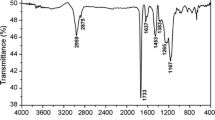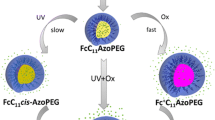Abstract
Intelligent polymers responsive to the environment have aroused widespread interest in many applications of materials and interfaces. However, sensitive control of the oil-water interface remains a major challenge, using reversible self-assembly of macromolecules induced by external stimuli. Here, we synthesized a new amphiphilic triblock copolymer responsive to pH and UV light via reversible addition–fragmentation chain transfer (RAFT) aqueous polymerization. Poly(methacrylic acid) (PMAA) acts as the hydrophilic block; poly(N, N-dimethyl aminoethyl methacrylate) (PDMAEMA) and poly(methacrylamide azobenzene) (PMAAAB) are the hydrophobic blocks with responsiveness. The as-synthesized polymer was measured regarding UV–vis transmittance and contact angle to verify the tunable amphiphilicity and wettability by the double stimulation. The newly developed dual-responsive polymer was applied for oil/water separation and controlled dye release, where methylene red (MR) was chosen as the representative adsorbate. With the synergic stimulation of pH and UV light, efficient separation for oil-in-water emulsions (separation efficiency: 66.8% in 15 min) and excellent desorption for adsorbed dyes (desorption efficiency: 93.8% in 15 min) are achieved.












Similar content being viewed by others
Data availability
The data will be available on request.
References
Ofridam F, Tarhini M, Lebaz N, Gagnière É, Mangin D, Elaissari A (2021) pH-sensitive polymers: classification and some fine potential applications. Polym Adv Technol 32(4):1455–1484. https://doi.org/10.1002/pat.5230
Musarurwa H, Tavengwa NT (2022) Recent progress in the application of PH-Responsive polymers in separation science. Microchem J 179:107503. https://doi.org/10.1016/j.microc.2022.107503
Mai BT, Fernandes S, Balakrishnan PB, Pellegrino T (2018) Nanosystems based on magnetic nanoparticles and Thermo- or PH-Responsive Polymers: an update and future perspectives. Acc Chem Res 51(5):999–1013. https://doi.org/10.1021/acs.accounts.7b00549
Cunningham MF, Jessop PG (2019) Carbon dioxide-switchable polymers: where are the future opportunities? Macromolecules 52(18):6801–6816. https://doi.org/10.1021/acs.macromol.9b00914
ACS Applied Materials & Interfaces (2022). https://doi.org/10.1021/acsami.2c19037
Selianitis D, Pispas S (2021) P(MMA-co-HPMA)-b-POEGMA copolymers: synthesis, micelle formation in aqueous media and drug encapsulation. Polym Int 70(10):1508–1522. https://doi.org/10.1002/pi.6229
McBride RJ, Miller JF, Blanazs A, Hähnle H-J, Armes SP (2022) Synthesis of high Molecular Weight Water-Soluble Polymers as low-viscosity latex particles by RAFT aqueous dispersion polymerization in highly salty media. Macromolecules 55(17):7380–7391. https://doi.org/10.1021/acs.macromol.2c01071
Wang T, Wang C, Ma H, Yu F, **a S, Han Y (2023) Preparation of Temperature-Sensitive SiO2-PSBMA for Reducing the Viscosity of Heavy Oil. Energy Fuels. https://doi.org/10.1021/acs.energyfuels.2c03650
Arredondo J, Woodcock NM, Garcia-Valdez O, Jessop PG, Champagne P, Cunningham MF (2020) Surface modification of cellulose nanocrystals via RAFT polymerization of CO2-Responsive monomer-tuning hydrophobicity. Langmuir 36(46):13989–13997. https://doi.org/10.1021/acs.langmuir.0c02509
Ge X, Mo L, Yu A, Tian C, Wang X, Yang C, Qiu T (2022) Stimuli-Responsive Emulsions: recent advances and potential applications. Chin J Chem Eng 41:193–209. https://doi.org/10.1016/j.cjche.2021.11.002
** H, Jessop PG, Cunningham MF (2022) CO2-Switchable PMMA latexes with controllable particle size prepared by surfactant-free emulsion polymerization. Colloid Polym Sci 300(4):375–385. https://doi.org/10.1007/s00396-022-04953-7
Hu L, Wang Y, Yin Q, Du K, Yin Q (2019) Multiple morphologies of a poly(methyl methacrylate)-block-poly(N,N-dimethyl aminoethyl methacrylate) copolymer with pH-responsiveness and thermoresponsiveness. J Appl Polym Sci 136(38):47972. https://doi.org/10.1002/app.47972
Shieh Y-T, Yeh Y-C, Cheng C-C (2019) Multistimuli-Responsive Emulsifiers based on two-way amphiphilic diblock polymers. ACS Omega 4(13):15479–15487. https://doi.org/10.1021/acsomega.9b01728
Ramezanpour M, Shirin-Abadi AR (2021) Emulsion polymerization using three types of RAFT prepared well-defined polymeric Stabilizers based on 2-Dimethylaminoethyl methacrylate (DMAEMA) under CO2 atmosphere: a comparative study. J Polym Res 28(7). https://doi.org/10.1007/s10965-021-02619-6
Yang Z, Chen S, Fu K, Liu X, Li F, Du Y, Zhou P, Cheng Z (2018) Highly efficient adsorbent for Organic Dyes based on a temperature- and PH-Responsive Multiblock Polymer. J Appl Polym Sci 135(34):46626. https://doi.org/10.1002/app.46626
Huang W, Si H, Qing Y, Zhang L, Zhang W, Song F, Ni X, Yang WA, Magnetic (2021) Core–Shell Structured, PH-Responsive molecularly imprinted polymers for the selective detection of Sulfamethoxazole. J Inorg Organomet Polym Mater 31(5):2054–2062. https://doi.org/10.1007/s10904-021-01893-7
Zhang X, Han L, Liu M, Wang K, Tao L, Wan Q, Wei Y (2017) Recent progress and advances in redox-responsive polymers as controlled delivery nanoplatforms. Mater Chem Front 1(5):807–822. https://doi.org/10.1039/c6qm00135a
Quinn JF, Whittaker MR, Davis TP (2017) Glutathione responsive polymers and their application in Drug Delivery Systems. Polym Chem 8(1):97–126. https://doi.org/10.1039/c6py01365a
Bertrand O, Gohy J-F (2017) Photo-Responsive P. Polym Chem 8(1):52–73. https://doi.org/10.1039/c6py01082b
Yang R, Liu Y, Chen J, Zhu W, Dong G (2019) Photo-responsive Block Copolymer Containing Azobenzene Group: synthesis by reversible addition‐fragmentation chain transfer polymerization and characterization. J Appl Polym Sci 136(33):47870. https://doi.org/10.1002/app.47870
Guo M, Yan Y, Zhang H, Yan H, Cao Y, Liu K, Wan S, Huang J, Yue W (2008) Magnetic and PH-Responsive Nanocarriers with Multilayer Core–Shell Architecture for Anticancer Drug Delivery. J Mater Chem 18(42):5104. https://doi.org/10.1039/b810061f
Zhou L, Yuan J, Yuan W, Sui X, Wu S, Li Z, Shen D (2009) Synthesis, characterization, and Controllable Drug Release of PH-Sensitive Hybrid magnetic nanoparticles. J Magn Magn Mater 321(18):2799–2804. https://doi.org/10.1016/j.jmmm.2009.04.020
Larik FA, Fillbrook LL, Nurttila SS, Martin AD, Kuchel RP, Taief KA, Bhadbhade M, Beves JE, Thordarson P (2021) Ultra-Low Molecular Weight Photoswitchable Hydrogelators. Angew Chem Int Ed 60(12):6764–6770. https://doi.org/10.1002/anie.202015703
Wang D-C, Yang X, Yu H-Y, Gu J, Qi D, Yao J, Ni Q (2020) Smart Nonwoven Fabric with Reversibly Dual-Stimuli Responsive Wettability for Intelligent Oil-Water separation and pollutants removal. J Hazard Mater 383:121123. https://doi.org/10.1016/j.jhazmat.2019.121123
Hosseini ZS, Abdollahi A, Dashti A, Matin MM, Afkhami-Poostchi A (2022) Synthesis of Tertiary Amine Functionalized Multi-Stimuli-Responsive latex nanoparticles by Semicontinuous Emulsion polymerization: investigation of responsivities and antimicrobial activity. J Mol Liq 352:118697. https://doi.org/10.1016/j.molliq.2022.118697
Nivaggioli T, Alexandridis P, Hatton TA, Yekta A, Winnik MA (1995) Fluorescence probe studies of pluronic copolymer solutions as a function of temperature. Langmuir 11(3):730–737. https://doi.org/10.1021/la00003a011
Ma H, **a S, Li N, Wang T, Zheng W, Yu T, Shu Q, Han Y (2022) Emulsifying Stability and Viscosity reduction for heavy crude oil in surfactant-polymer Composite System. J Mol Liq 362:119713. https://doi.org/10.1016/j.molliq.2022.119713
Hu X, Li Z, Ge Y, Liu S, Shi C (2022) Enhanced π-π stacks of aromatic ring-rich polymer adsorbent for the rapid adsorption of organic dyes. Colloids Surf A 643:128782. https://doi.org/10.1016/j.colsurfa.2022.128782
Jiang L, Wen Y, Zhu Z, Liu X, Shao WA (2021) Double cross-linked strategy to Construct Graphene Aerogels with highly efficient Methylene Blue Adsorption performance. Chemosphere 265:129169. https://doi.org/10.1016/j.chemosphere.2020.129169
Acknowledgements
This study was supported by the National Key Research and Development Project under Grant No. (2018YFA0702400).
Author information
Authors and Affiliations
Corresponding authors
Ethics declarations
Conflicts of interest
The authors declare that they have no known competing financial interests or personal relationships that could have appeared to influence the work reported in this paper.
Additional information
Publisher’s Note
Springer Nature remains neutral with regard to jurisdictional claims in published maps and institutional affiliations.
Rights and permissions
Springer Nature or its licensor (e.g. a society or other partner) holds exclusive rights to this article under a publishing agreement with the author(s) or other rightsholder(s); author self-archiving of the accepted manuscript version of this article is solely governed by the terms of such publishing agreement and applicable law.
About this article
Cite this article
Ma, H., Cameron, A. Dual-responsive polymers synthesized via RAFT polymerization for controlled demulsification and desorption. J Polym Res 30, 278 (2023). https://doi.org/10.1007/s10965-023-03642-5
Received:
Accepted:
Published:
DOI: https://doi.org/10.1007/s10965-023-03642-5




